Empathy, ergonomics, and how BRAC’s human-centered design includes its architecture
“We did not want the building to be the protagonist. We wanted the people to be the protagonists of our architecture… we saw success in attracting people and giving them an experience of hope.” –Dr. Adnan Morshed, scholar, architect, architectural historian, urbanist, and columnist
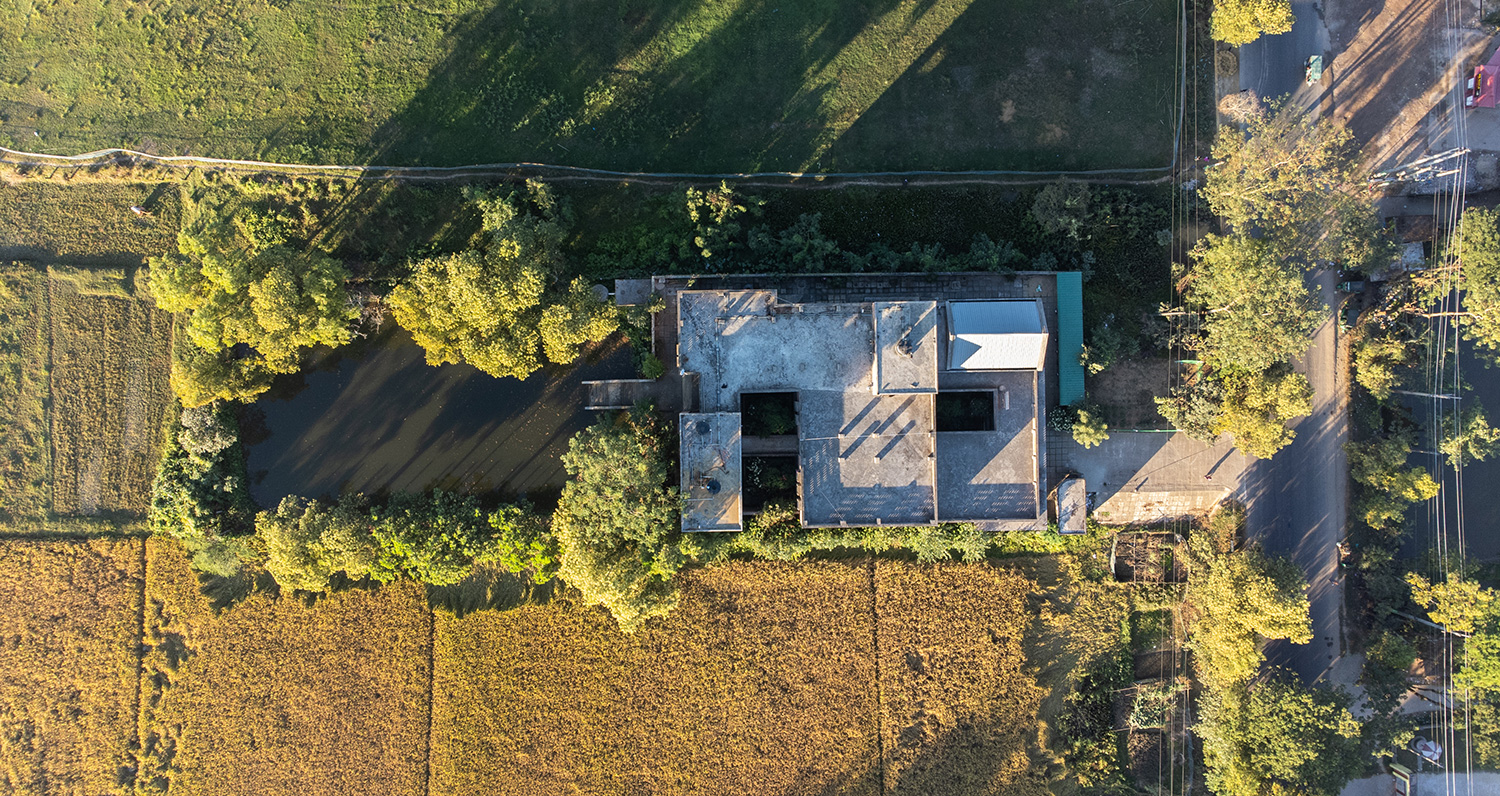
BY DAVIS CONNELLY
Photo by Asif Salman.
On the eve of Bangladesh’s 53rd Independence Day, Davis Connelly from BRAC USA interviewed Adnan Z. Morshed, Ph.D. to discuss two of his recent exhibitions, Recalling 1971: The Liberation War Memorabilia and Architecture as Freedom: An Exhibition of BRAC Regional Offices.
Adnan Z Morshed, Ph.D. is a professor at the School of Architecture and Planning at Catholic University of America, Washington, DC. and was formerly Chairperson at the Department of Architecture of BRAC University, Dhaka. He currently serves as executive director of the Centre for Inclusive Architecture and Urbanism. He received his Ph.D. and Master’s in architecture from MIT.
Watch: Architecture as Freedom.
This interview has been edited for clarity and brevity.
Davis: You were recently at the District Architecture Center in DC. Can you talk about your “Architecture for Freedom” exhibition?
Adnan: Yes, BRAC reached out to us in 2017 and asked us if we would be interested in designing the next generation of BRAC field offices across rural Bangladesh. As you may know, the first generation of BRAC’s rural offices were built in the ‘70s or ‘80s. That was the pre-internet era, and many of the technologies that we take for granted today were not even on the horizon.
It was a fantastic philosophical challenge. How do you create buildings that will provide its primary clientele, people in poverty, an experience of hope? I was very pleased how, with minimal resources, we were able to craft buildings that don’t feel intimidating. We wanted to make sure these were not corporate headquarters, not glamorous edifices, but buildings that will welcome people in poverty.

So, at the beginning of last year, we reached out to The American Institute of Architects, Washington, DC chapter. We proposed organizing this exhibition, which we called “Architecture as Freedom.” We had an opening reception which was attended by over 200 people, including politicians, Congressmen, academics, design professionals, students, researchers, members of the development community, State Department, and the World Bank official, et al.
We were very pleased to bring the exhibition to a wide audience, because I think it is not just about architecture. For us, it was a story about development, which I think resonated with a broad audience interested in learning about human stories in the Global South, representing different disciplines.
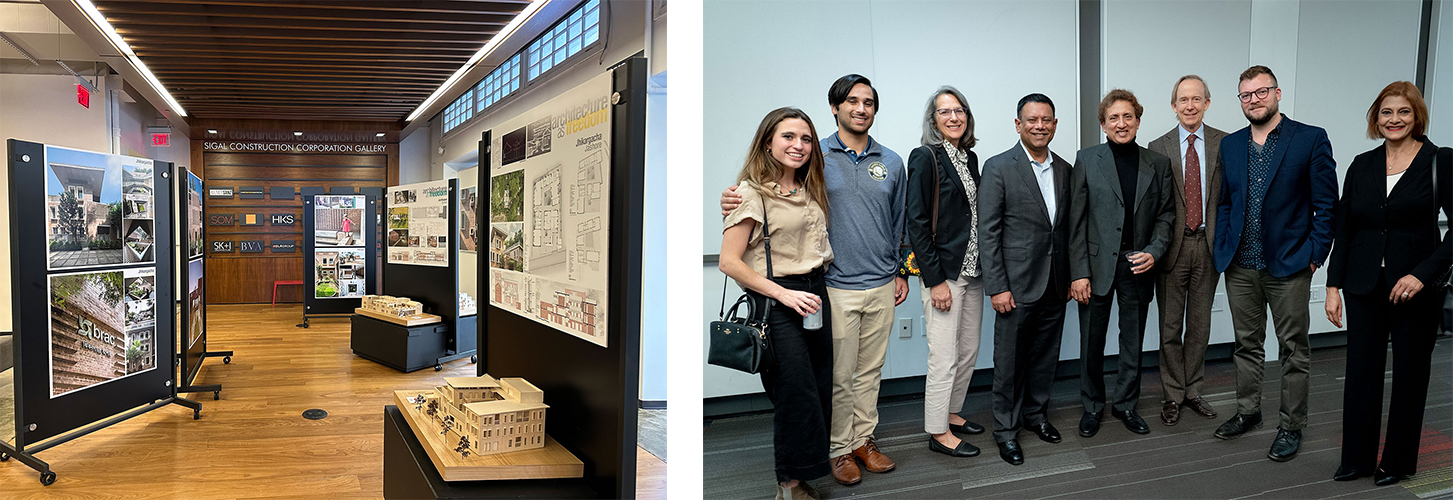
Davis: What types of activities did you have in mind in designing the spaces, for people who otherwise wouldn’t know?
Adnan: When discussing the project with BRAC, they wanted us to accommodate over 14 programs in a small plot of land. Those 14 programs included microfinance, education, health care, community empowerment, human rights and legal services, climate change, migration services, skills development programs, gender justice, and more.
We were obviously daunted. We were kind of intimidated by the range of programs. We needed to not only provide offices for these programs, but also create zones within these very compact spaces. Microfinance for example, a bureau with a lot of financial transactions, required a secure zone. So it required its own spatial clarity.
 Photo: Adnan Morshed
Photo: Adnan Morshed
In a rural area, designing a mosque, house, school, or factory could be pretty straightforward. But BRAC offices were particularly challenging because they had so many uses, and they needed different access points and different kinds of collaborative spaces. Most importantly, they needed to appeal to the poor who often feel discriminated against by the system or intimidated by the bureaucratic nature of office culture. We wanted to create a type of space that would inspire the poor to overcome those mental challenges.
 Photo: Asif Salman
Photo: Asif Salman
Davis: When I was visiting both urban and rural BRAC outposts around Dhaka, I saw a lot of different programs taking place in an open, outdoor setting. It’s challenging to think about all of these different activities being housed in one building.
For people outside the architectural world, can you talk about what it means to “spatialize” freedom?
Adnan: When BRAC’s founder, Sir Fazle Hasan Abed, asked us to take on this project, the fundamental philosophical challenge for us was, “How do you make these buildings work for their primary clientele, the poor community of rural Bangladesh?”
Then we began to think, “What is poverty in the first place?” And to understand poverty from BRAC’s perspective, we looked at Abed’s writings, his speeches, and his thinking. Who are the people impacted? What is their mindset? What are the biggest challenges that they face in their lives?
 Photo: BRAC University
Photo: BRAC University
Often, what happens in development initiatives is that experts, governments, policymakers come in and drop the development model from the clouds, and the “poor” are seen as passive recipients who have to swallow that development model. Which often doesn’t work, right?
We figured that development is not just to be given. People cannot just be told, “Pursue this path and you can transcend your poverty.” We sought to champion that freedom to choose the path you want for your development is the first need in the fight against poverty meaningfully.
So freedom, for us, was a primary tool to overcome poverty. We read Pedagogy of the Oppressed, by the Brazilian educator, Paulo Friere. We thought about the kind of fatalism and helplessness that the poor feel in their everyday lives. We also read Development As Freedom, by Nobel Laureate and economist Amartya Sen, who also talked about freedom as a fundamental requirement of development.
For us, freedom was fundamental. Freedom to choose, freedom to decide what’s best for you, freedom to pursue what you deem most effective.
Freedom, in our design, meant accessibility and familiarity. There are no walls that separate the client and the service provider. We created unobstructed, accessible courtyards, a comfortable environment, and an environment that is naturally ventilated. There is natural light and traditional material that creates a familiar space for people, like the common courtyards that they have in their communities.
 Photo: Shafaiet Mahmud
Photo: Shafaiet Mahmud
We took inspiration from vernacular rural architecture and the nature of pastoral landscape, yet transcended all of it to achieve an architecture of humble, environment-friendly modernity. …. In other words, spatialize freedom by embodying the spaces that the rural communities are familiar with but not being limited to that familiarity alone. Create space that would also inspire them about the future of their lives.
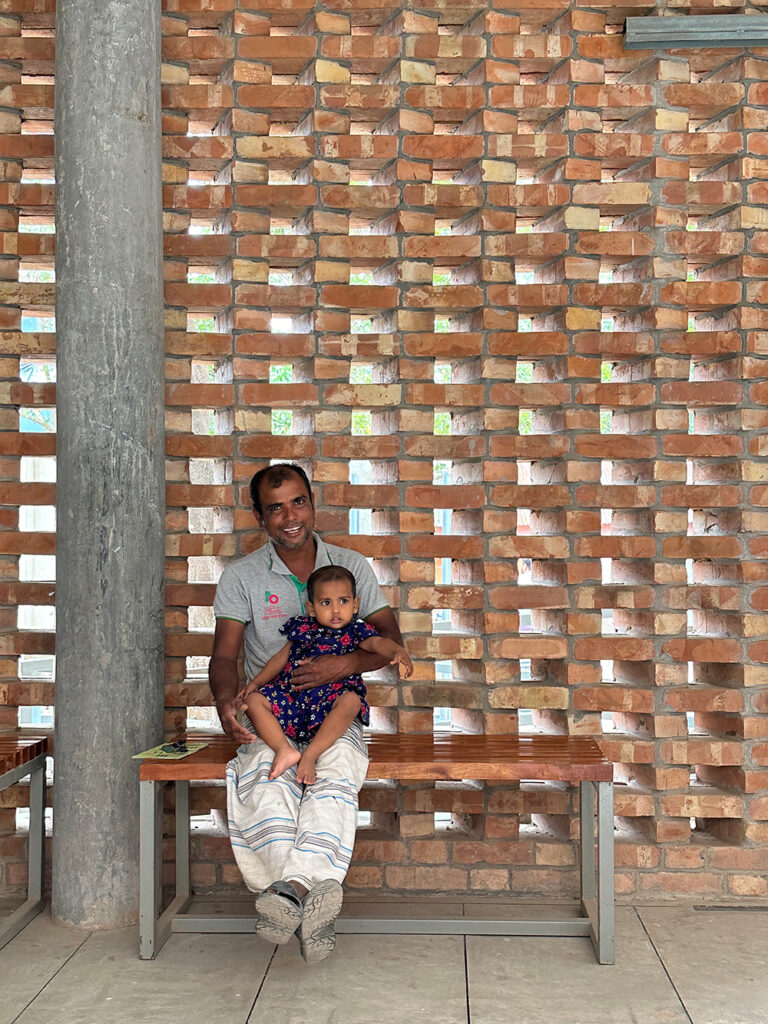
If you go to a BRAC office, you will see that people bring their children. They’re taking selfies. The courtyards have brick walls, little benches… A husband is with his child on his lap while his wife goes inside to secure a loan.
To us, these are images of freedom, images of welcome, images of acceptance. You can be who you are. Spatializing freedom means you make the participant feel that you are part of the development journey. They are not a passive recipient of the development mantra, they are a shaper of it. They are the protagonists.
Davis: I can understand the synergy between you and our founder, “Abed bhai,” believing in empathy, working directly with people, and this very human-centric design.
Adnan: Yes, as you say—people-centrism. We needed to translate it into our design. We did not want the building to be the protagonist. We wanted the people to be the protagonist of our architecture. That’s why whenever we visit our offices, we take pictures of people feeling comfortable in these buildings rather than photographing the buildings in isolation. In other words, we did not want isolated, beautiful buildings, rather we saw success in attracting people to these buildings and giving them an experience of hope while within the deliberately designed humility of these buildings’ physical and social environment.
Davis: Ergonomics, on a whole other level.
Adnan: Exactly! And you used the word empathy and I think without empathy, without understanding the mental universe of those in poverty, you cannot design to help people defeat poverty. You need to understand how to define poverty and how people see themselves. You must understand this in order to create something that works.
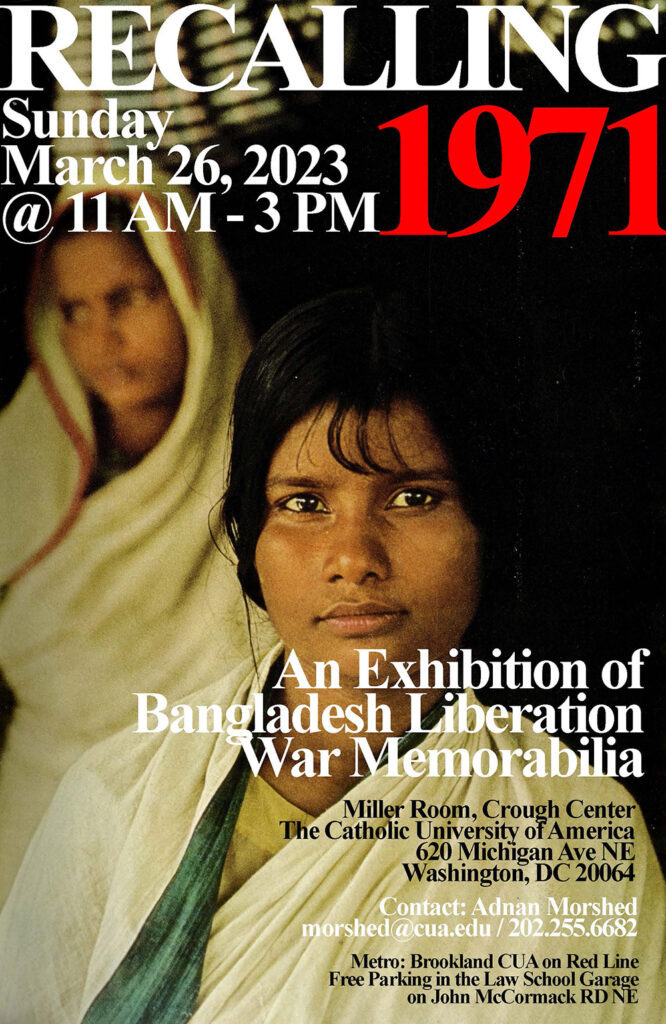
Davis: This March marked 53 years of independence in Bangladesh. I wanted to discuss your other recent exhibition, “Recalling 1971.” It was striking to see so much memorabilia from the war. But even more memorable to me was the incredible presentation of the personal stories of people who witnessed the bloodshed.
Because it’s such a young nation, Bangladesh is unique. You have all these people with sometimes heartbreaking, but nonetheless incredible, firsthand stories. Can you speak more about your exhibition, and the emotional toll of that period?
Adnan: I’m glad that you brought it up. We organized this exhibition of 1971 war memorabilia. It was very important to us to commemorate that a genocide had occurred. The bloody birth of Bangladesh was a story to be told to a larger, global audience with emotion–the turmoil and the atrocities that occurred. It was also important to narrate the context that led to the liberation war. The Bhola cyclone in southern Bangladesh in 1970 was one of the key moments in that context. One of the most devastating cyclones in human history, between 300,000 to 500,000 people perished in just one night, on November 12, 1970. But there was no aid. There was no support from West Pakistan. It outraged Bengalis, they understood that this lack of assistance was the tragic outcome of the asymmetrical power relationship between the two wings of Pakistan since Partition in 1947. In my writing, I described the doomed political geography, separated by a so-called “hostile” India between two wings of Pakistan.

The birth of BRAC was deeply intertwined with the birth of Bangladesh. BRAC was established in 1972 as an assistance program to help the people displaced by the independence war. Abed was working in Bangladesh at the time, and as you know, the program would eventually balloon into what we know as BRAC today.
Coming back to the exhibition, my wife and I thought that it was very important to organize an exhibition to tell the story of the birth of Bangladesh to a broader community, not just to Bangladeshi diaspora, but a global community in Washington, DC, including somebody like you, who’s not a Bangladeshi but need to know the history of genocide in the 20th century. As an American, you came down and saw this exhibition. You felt the gut reaction of many of the participants, the personal collections of materials, and so on. It is a story of a country hobbled by poverty, lack of resources, and a lack of political power. I don’t know if you would remember, but in the exhibition there were a few items that showcased the devastation of the Bhola cyclone. The disaster and its aftermath. I think, in a way, telling the story of the birth of Bangladesh in a way is also telling the story of the birth of BRAC and the bottom-up development path it pursued.

Davis: Absolutely. I was very pleased to see some of our dedicated donors and supporters come out to the exhibition to learn more about the heartbreaking history of Bangladesh, and the conditions that gave rise to the BRAC story.
The whole thing is incredible and very sad, yet there was this spirit of resilience and ingenuity that persists. When I spoke with participants in our programs, they all had these underlying values and sense of hope. It’s all about protecting their families, and raising their children to give them a better chance to achieve their potential.
Fast forward a few decades, and now BRAC reaches over 100 million people across 17 countries. What does this mean to you as someone from Bangladesh that people all over the world are hearing this story, understanding its gravity, and taking action?
Is it important to you personally that people, globally, are signing up to give a gift every month, large or small, and joining our circle of supporters that are making this huge difference?
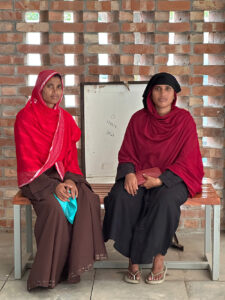
Adnan: All of this is true and the bigger question is, why shouldn’t BRAC appeal to a global audience of supporters? Whenever I see BRAC’s story being told, there is a great deal of curiosity. How does this organization achieve so much and lift so many people out of poverty?
When I was having a conversation with Sir Fazle Hasan Abed around 2018, I came to understand that BRAC helped people not only to grow out of poverty, but also to transform their mindset. I think one of the greatest contributions of BRAC was to help people understand that poverty is not destiny.
This may sound simple but in fact it is one of the greatest and most useful lessons learned from the BRAC experience with which the development communities around the world could imagine a better, humane future for all.
Davis Connelly is Manager, Individual Giving at BRAC USA.